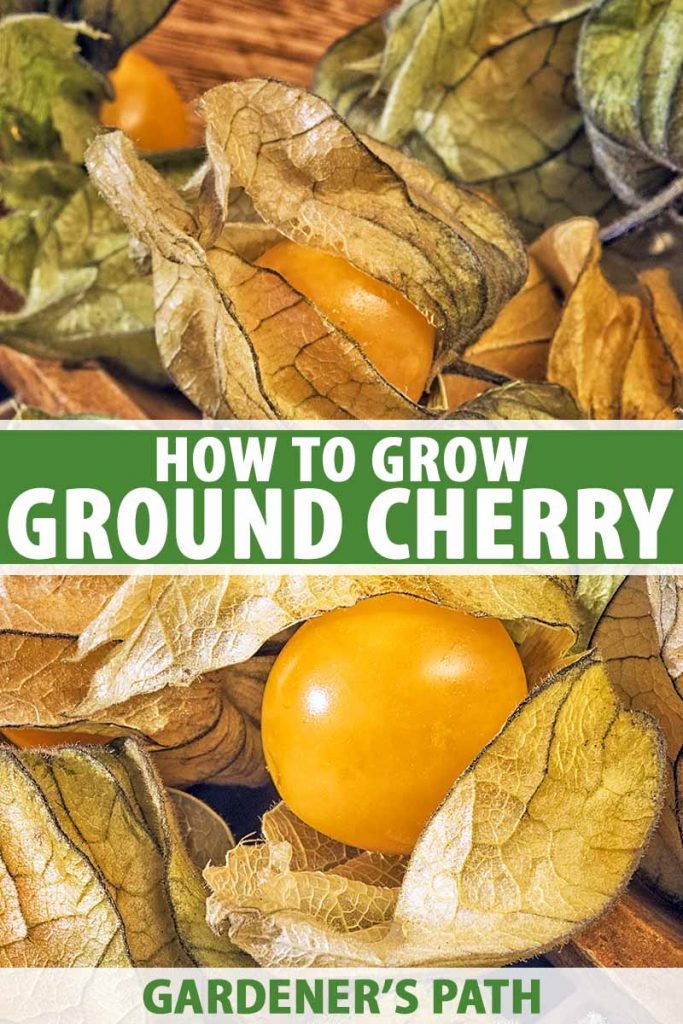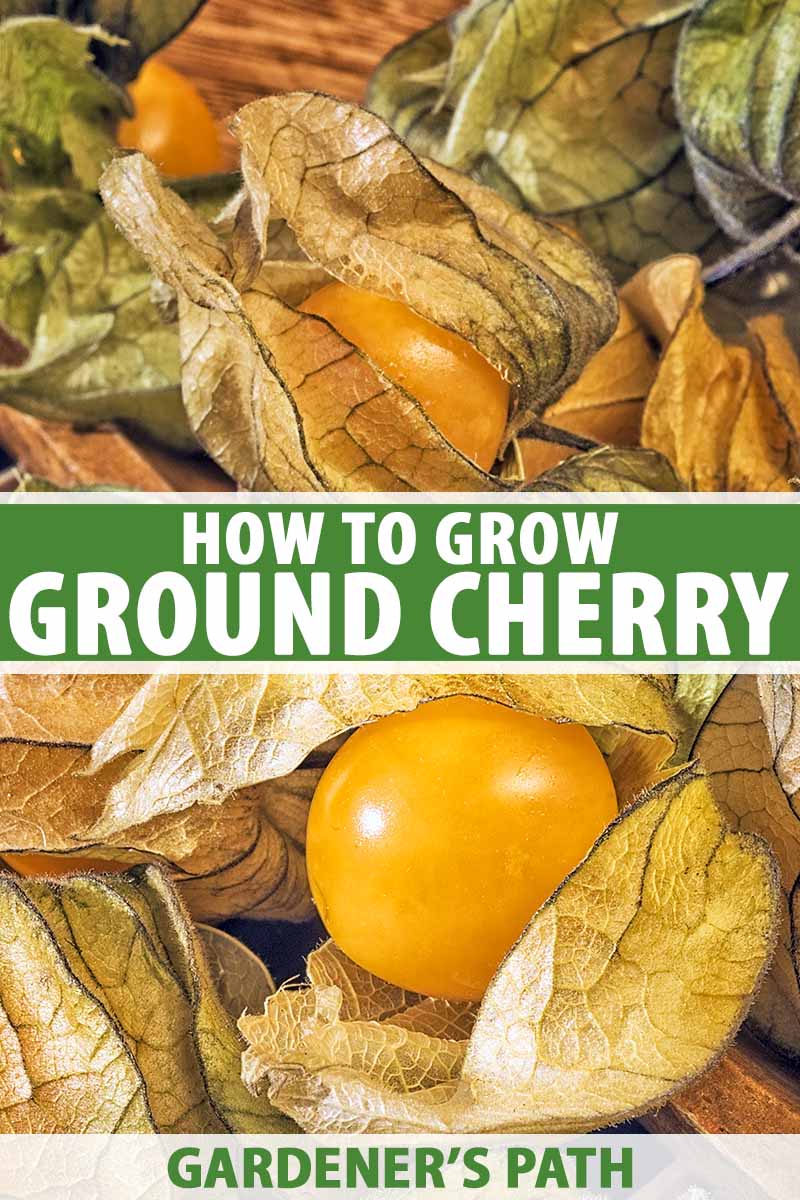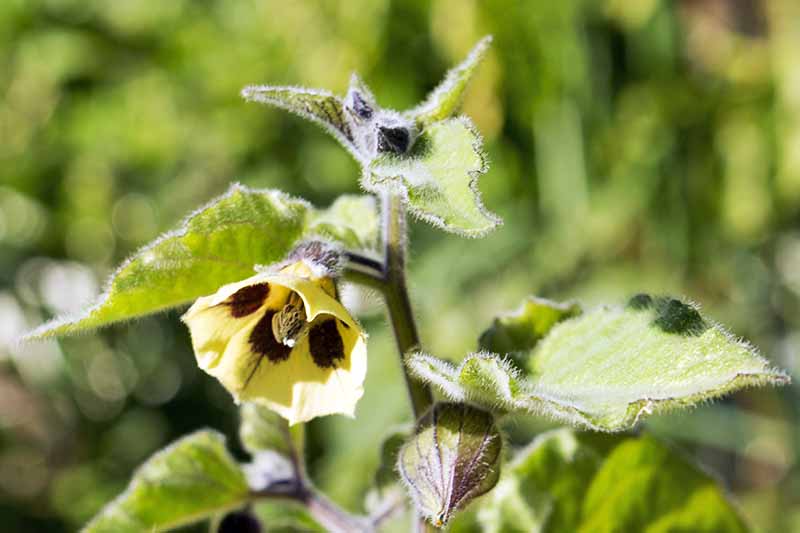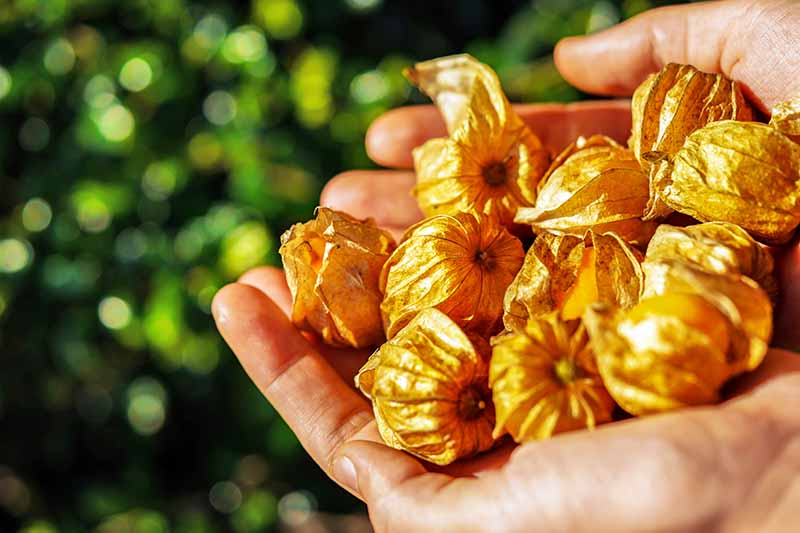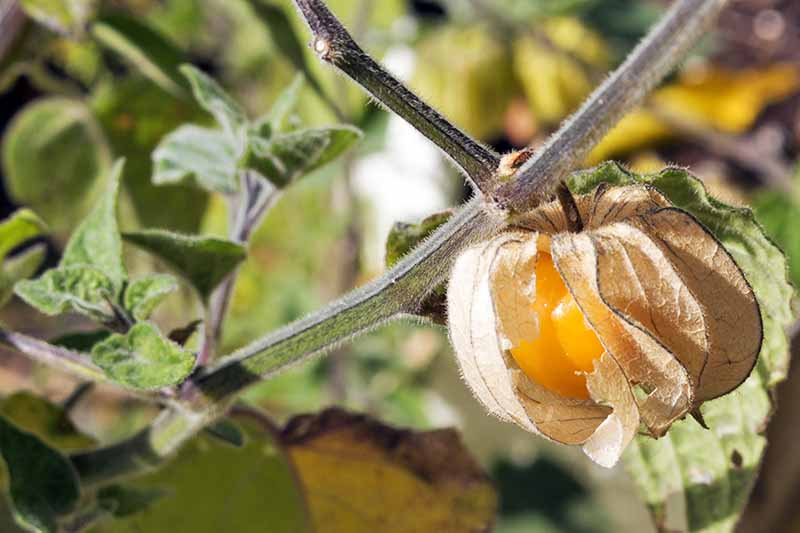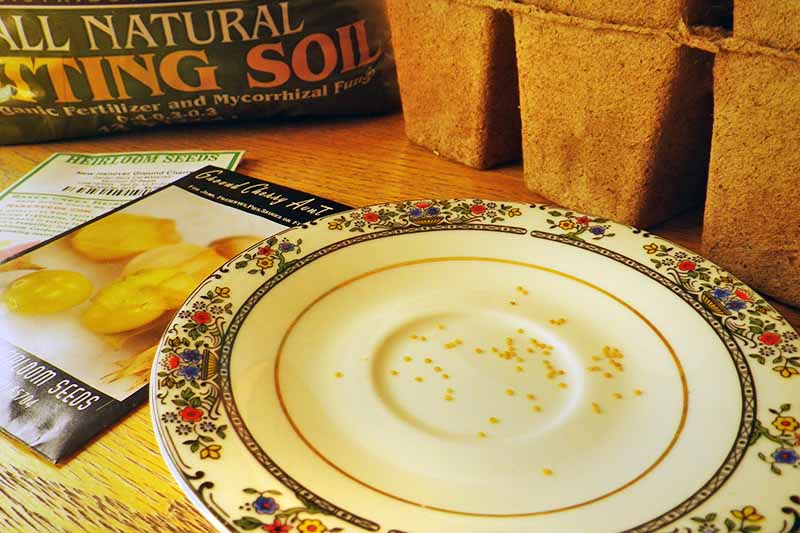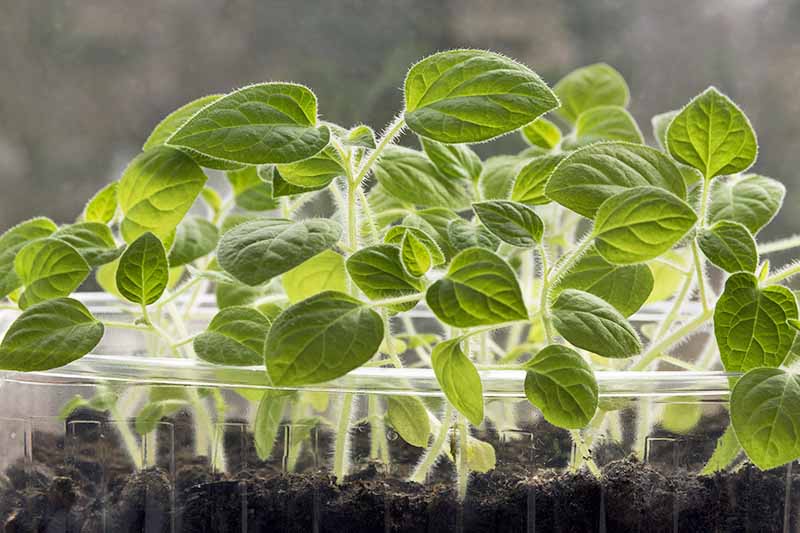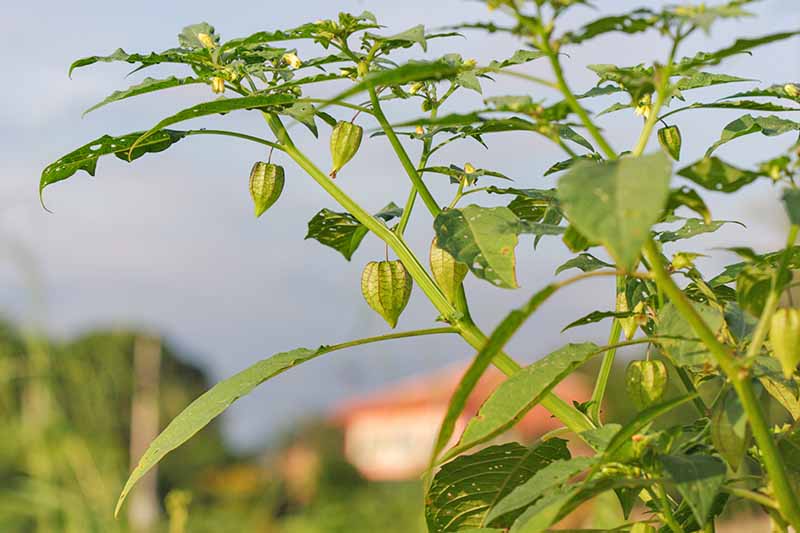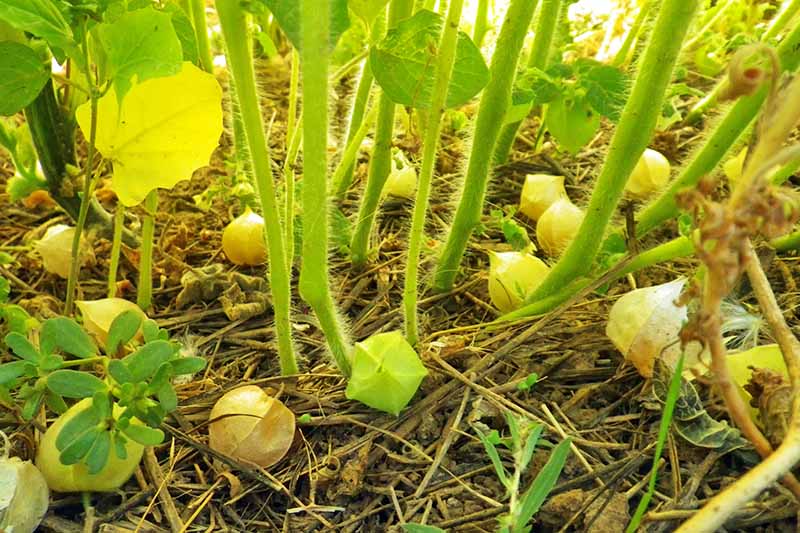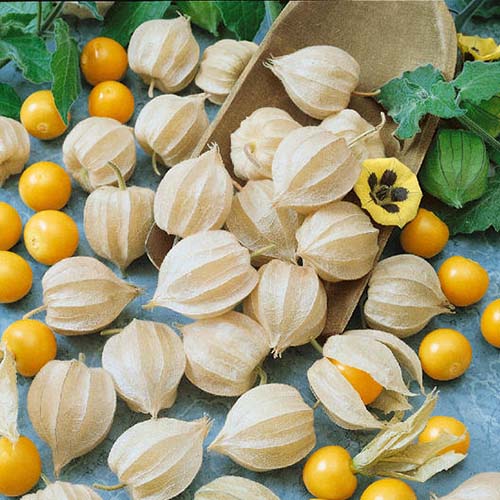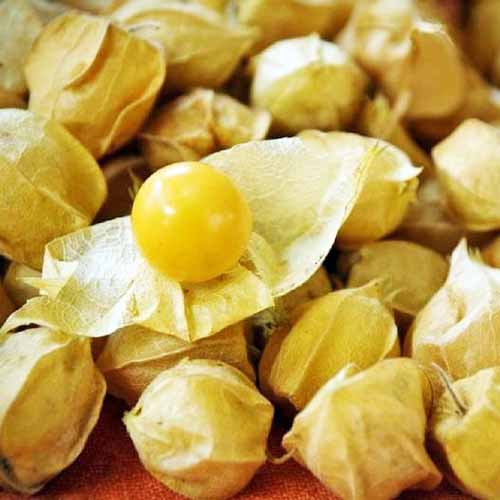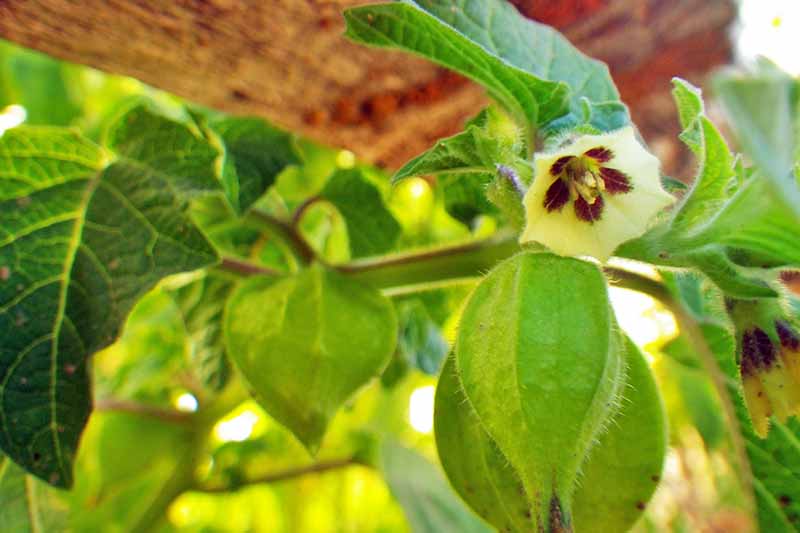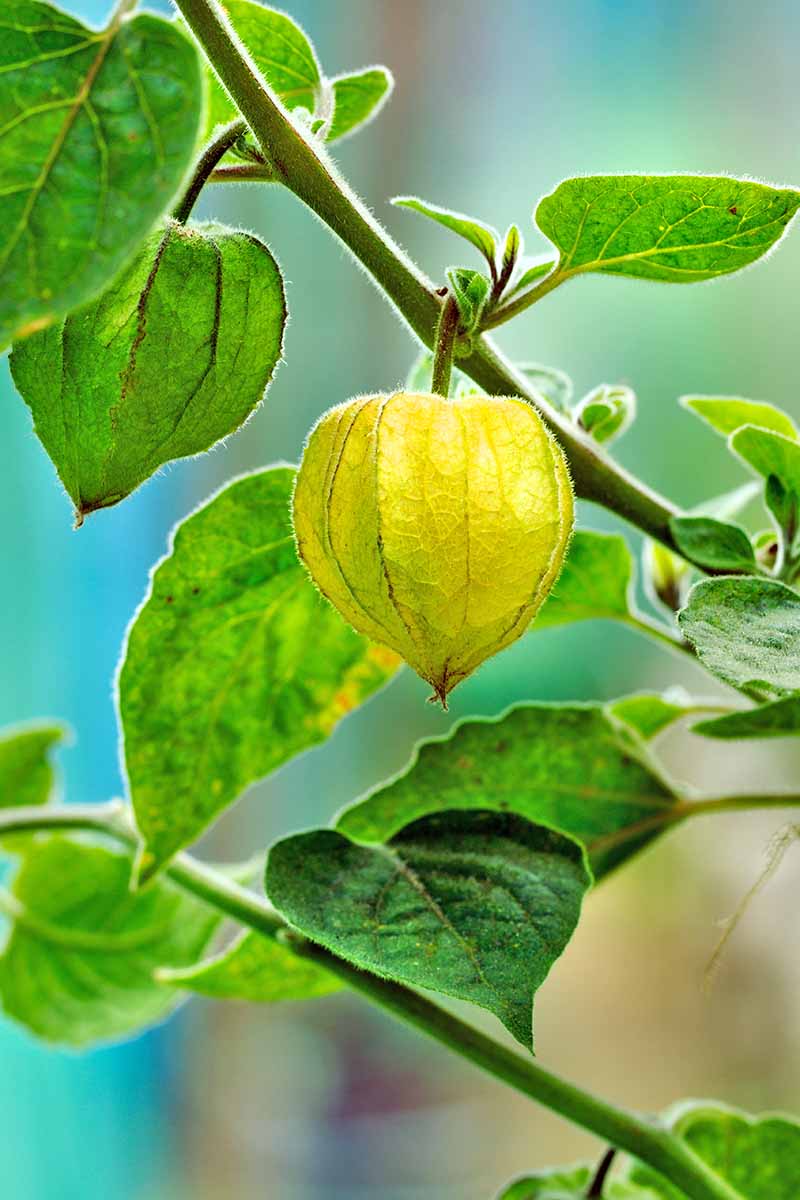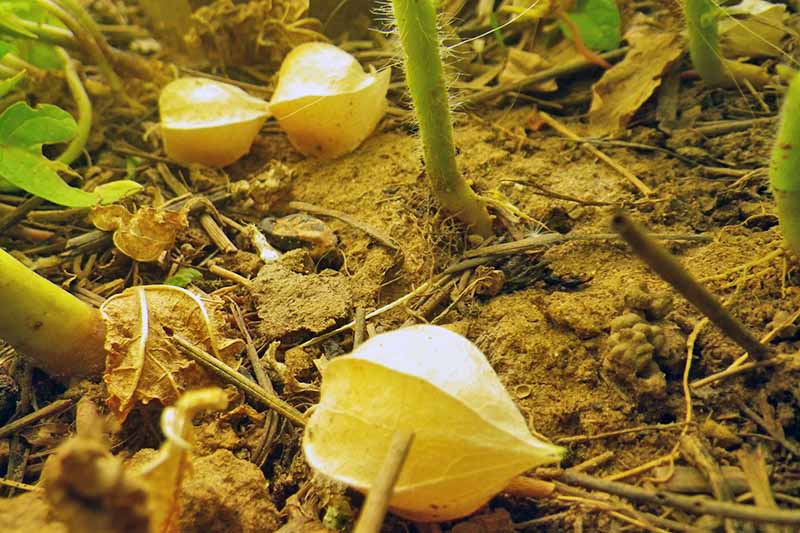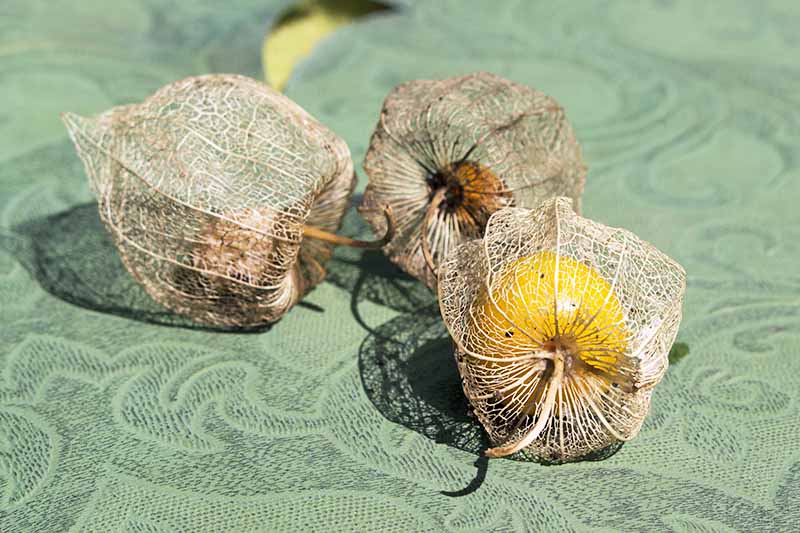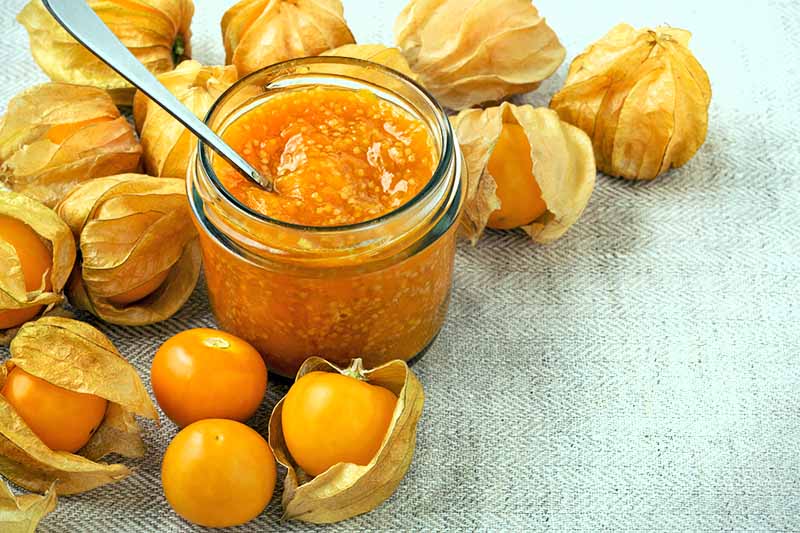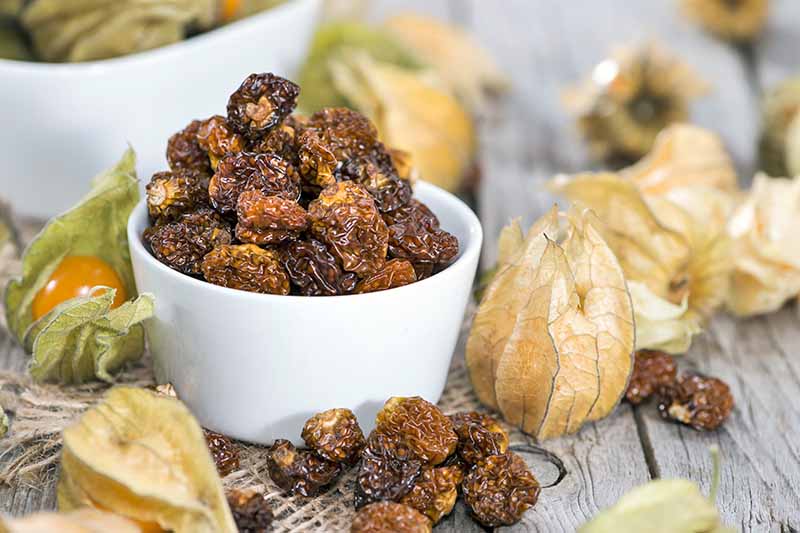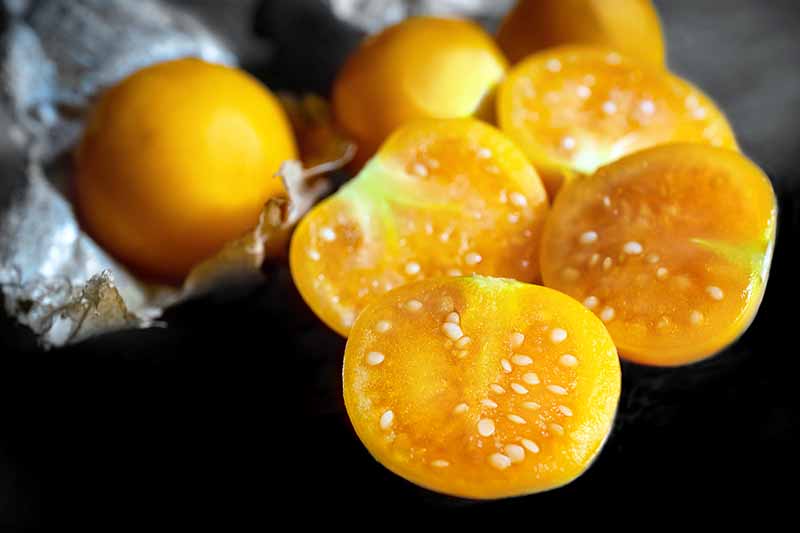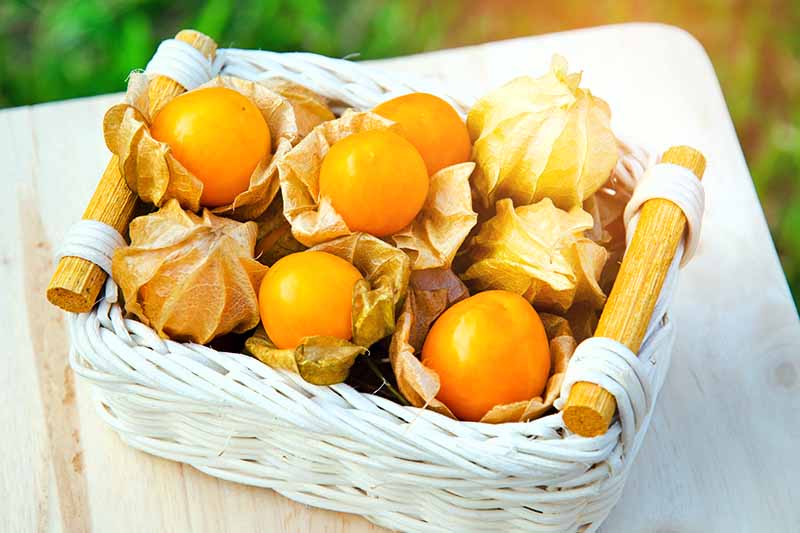Related to the ubiquitous garden tomato, these summer annuals can be included in your veggie garden to provide a crop of delicious, tropical-flavored fruit in just one growing season. Ground cherries are known by a seemingly endless list of common names, including Cape gooseberry, poha berry, pichuberry, ground tomato, strawberry tomato, golden berry, Inca berry… and the list goes on! We link to vendors to help you find relevant products. If you buy from one of our links, we may earn a commission. Let’s dig in:
What Are Ground Cherries?
Here’s a member of the nightshade family that will inspire your sweet tooth. If the leaves and flowers look familiar, that’s because these plants are related to eggplants and tomatoes. In fact, they are sometimes referred to as “husk tomatoes.” The plant can grow low, hugging the ground, or more upright, depending on the variety and growing conditions. They have velvety leaves, purple-veined stems, and tend to sprawl.
Ground cherry flowers are bell-shaped and white to yellow with purple centers. Fruits grow inside of lantern-shaped husks that turn from green to tan and take on a papery texture when the berry inside is ripe. The husks eventually break down, leaving a delicately webbed encasement around the berry.
These delicious orange-yellow berries have a tropical taste that some describe as pineapple with a hint of vanilla, and others describe as strawberry with tomato undertones. It’s their pronounced tart flavor that everyone will agree on.
Cultivation and History
The term “ground cherry” refers to several species of Physalis plants. While there are at least 75 species of Physalis, not all of them have edible fruit. One of the most distinctive members of this genus is Chinese lantern (P. alkekengi), a unique plant that is grown as an ornamental rather than for its berries.
Edible ground cherries may not have the showy color of Chinese lantern, but their husks enclose a foodie’s delight. While this fruit may be trending as a superfood, it has been cultivated since the 17th century, according to Karen Hager at the Roanoke Times. One of the most common types, P. pruinosa, is native to warm, subtropical Central America like its relatives, tomatoes and tomatillos. Another species native to Peru and Chile, P. peruviana, is commonly called Cape gooseberry or golden berry. Many species of ground cherry have naturalized in North America, but the most common place that many of us will find ground cherries is in heirloom seed catalogs, rather than in our own backyards.
Propagation
Speaking of seed catalogs, are you ready to try growing your own ground cherries? You can plant transplants directly into your prepared garden soil, start seeds indoors, or even try direct sowing.
From Seed
Most seed companies recommend starting the seeds indoors rather than direct sowing. But the ease with which these seeds grow as volunteers is proof that direct sowing is certainly an option. If you do choose to direct sow, plant seeds after your last frost. Loosen the soil and work in some compost. Moisten the soil then pat it down gently without compressing it. Place your seeds on top of the soil and then cover lightly with a thin layer of soil, about 1/4 inch. Pat soil gently. Water after planting seeds, and then daily with a gentle spray from your watering wand until the seeds are established. Seeds should germinate in approximately five to eight days. Ground cherry seeds have a low germination rate, so plant more than you need. When seedlings are well established, thin them so plants have at least two square feet to spread.
From Seedlings or Transplanting
Start seeds indoors six to eight weeks before your last frost. You’ll find all you need to know about starting seeds indoors in our guide. If you want to skip the seed starting business altogether, you can obtain transplants from heirloom seed companies such as Seed Savers Exchange. Or ask your local nursery!
When planting seedlings or transplants, wait until two to four weeks after your last average frost. Harden off before transplanting into a sunny location with well-drained soil. Ground cherries are notorious self-seeders, so plant once and you may never need to plant them again!
How to Grow
Plant seedlings or transplants in well-drained soil amended with compost. Don’t over water – they don’t like to keep their feet wet. If you have heavy clay soil, you may want to plant them in a raised bed. In my drylands garden, they do great in a sunken row.
If planting in containers, make sure the roots have plenty of room. Each plant should be in a gallon-sized pot or larger. Whether growing them in the garden or in containers, make sure you give them room to sprawl – a single plant can take up 2 to 3 square feet. They generally do not need to be staked, though some gardeners do stake leggier plants.
Growing Tips
Mulch beneath the plants with straw for easier harvesting and to conserve water. The plants will produce more fruit in full sun but can tolerate light shade.
Cover with a row cover if there’s a risk of frost, and to extend your growing season. As always, when you plan your garden next year, make sure to rotate your nightshades to prevent nutrient depletion and the spread of disease.
Fencing will certainly help keep the bigger critters out, and floating row covers will offer even more protection. And there are many other edible species, including the “clammy” type (P. heterophylla, aka Rowell’s ground cherry), which is native to the US and hardy in Zones 7-10. Another US native, “common ground cherry” (P. longifolia) was used by Native Americans for food. A garden full of a variety of different species would be a beautiful thing! But most likely, you’ll want to start with the basics. The most commonly available seeds are cultivars of P. pruinosa.
Aunt Molly’s
‘Aunt Molly’s’ is the classic ground cherry, the most widespread cultivar of P. pruinosa and the most common variety to buy as a transplant. The fruit is sweet, tart, and tropical.
Ground Cherry
This open-pollinated variety of P. peruviana produces one-inch, golden fruits with a sweet, slightly tart flavor.
‘Ground Cherry’ Seeds are available at Eden Brothers.
Mary’s Niagara
This variety of P. pruinosa is very low growing with a wider, three- to four-foot spread. The fruits ripen earlier than other varieties, so it is good for climates with short growing seasons. It is said to have a subtle sweet flavor.
New Hanover
Some think this is better tasting than the ‘Aunt Molly’s’ cultivar. This is another sweet and fruity variety of P. pruinosa.
Pineapple
Also known as ‘Cossack Pineapple,’ this P. pruinosa cultivar produces fruit that tastes like – you guessed it – pineapple! The berries are fruity and sweet.
‘Pineapple’ Seeds are available from Eden Brothers Nursery. No matter where you live in the US or which cultivar you pick, you should be able to harvest fruit in one season.
Managing Pests and Disease
If you’re a laid back type of gardener, then ground cherries should be part of your repertoire. These plants are not particularly prone to bacteria, fungi, or viruses. Although they are rarely targeted by garden critters, occasionally you may find your plants visited by some unwelcome guests.
Herbivores
Ground cherries may attract the same types of animals as your other tasty garden goodies – squirrels, raccoons, rabbits, possums, and deer. Luckily the ripe fruit are fairly well-hidden, so most four-legged garden intruders will not find them easily.
Insects
While ground cherries aren’t particularly prone to insect problems, there are a few bugs that might find your plants as delicious as you find the fruit!
Cutworms
Cutworms can be a problem for young seedlings. Protect seedlings with plant collars or by sprinkling eggshells or coffee grounds around the base of young plants. Be sure to correctly identify these guys, as they look similar to some beneficial butterflies. Read our complete guide to cutworm control for more tips.
Tomato Hornworms
Tomato hornworms will munch on any nightshade plant, so ground cherries are definitely on the menu. Inspect your ground cherry plants (and other nightshades) for these big, juicy caterpillars and remove them. They make excellent treats for your chickens, or can be squashed under your heel. Learn more about combating tomato hornworms here.
Colorado Potato Beetles and Ground Cherry Leaf Beetles
These beetles are easy to spot – although they are on the small side, they look like little clowns with their bright yellow and black stripes. If you find any on your plants, pick them off and squish them. Find tips on colorado potato beetle control here.
Flea Beetles
Flea beetles are tiny beetles that will chew holes in the leaves of your ground cherry plants. In healthy plants, this will probably only be an aesthetic concern. Plant basil nearby to repel these pests. Read our guide on flea beetle control for more tips. Your main strategy for keeping your ground cherry plants insect-free should be inspecting your plants regularly. And since nightshade-loving pests tend to eat any member of this plant family, keeping your tomatoes, eggplants, peppers, potatoes, and ground cherries separated with non-nightshades will keep those pests from smooth sailing on the free food expressway!
Harvesting
Ground cherries have so many things going for them – they are tasty, easy to grow and even easy to harvest. How do you know when it’s time to harvest them? When the berry ripens, it falls to the ground in its protective husk – thus the name! The berries will ripen gradually after the plants reach maturity, usually starting in July or August and up until your first frost.
On ripe fruit, husks will be straw-colored and papery while the fruit inside will be somewhere in the yellow to orange range. Leave green-husked fruit on the plant to ripen. Once you start noticing ripe fruit, look underneath the plant every day or so to collect any fallen berries. Mulching under your plants will make harvesting easier. Use floating row covers to extend your growing season, but when it’s time to put the garden to bed for winter, you can harvest unripe berries in their husks. Store unripe fruit at room temperature in a single layer to ripen. Smaller fruit may not ripen fully – only eat those that are ripe as the leaves, stems, husks, and unripe fruit may be toxic.
As for ripe fruit, they will keep longer in a cool environment, such as a fridge, basement, or root cellar. For longer storage, just make sure to keep them unwashed and in their husks. According to Brenda Lynn at Mother Earth News, ripe ground cherries can be stored for 3 months in the right conditions.
Preserving
Another thing to love about these members of your garden is that a single plant can produce hundreds of berries. These berries are a great source of antioxidants and vitamins A, and C, but also vitamins B-1, B-2, and B-3. Consider preserving your harvest if you grow a bumper crop. Before preserving, remove husks, and rinse berries. You can preserve them by making jam, dehydrating, freezing, or fermenting.
Leave fruits whole or cut them in half for jam. Jam made with ground cherries will brighten up your winter and make exciting gifts for your foodie friends. Find tips for making your own jams and jellies on our sister site, Foodal. You can dehydrate ground cherries in much the same way as you would dehydrate grapes to make raisins. Dehydrating concentrates flavors, so you can use your dehydrated harvest to flavor muffins or cookies, add them to trail mix for a burst of tartness, or sprinkle them on top of your oatmeal. Read more about dehydrating the garden’s bounty on Foodal.
The fruit can also be frozen for later use. Place clean fruit on a baking sheet, then place the baking sheet in the freezer. Freeze for half an hour or so, then remove the baking sheet and put the flash-frozen ground cherries in a reusable glass container. Store the container in the freezer. Read more about the ins and outs of freezing garden produce now on Foodal.
Cooking Ideas
If you don’t eat them all in the garden, cooking the berries is a delicious way to transform them. Cook them down into a sauce to drizzle over vanilla ice cream or plain yogurt. Or chop them up with some hot peppers, onions, and cilantro and turn them into a peppy salsa!
When I lived in Paris, I would often see a single ground cherry placed as a garnish on top of a dessert with its papery husks folded back like wings. So pretty!
Quick Reference Growing Guide
A Taste of the Tropics, Fresh from Your Garden
Ground cherries will add an exciting new flavor to your veggie garden, and when you pop open that jar of ground cherry jam mid-winter, its tartness will contrast beautifully with the winter weather.
Do ground cherries brighten up your life as much as they do mine? If so, tell me about it in the comments. If you want to learn more about nightshades or growing rare fruit, here are a few more guides you’re bound to need:
How to Grow and Harvest Tomatillos Grow Tomatoes From Seed In 6 Easy Steps How to Grow Loquat 17 Unusual Fruits and Vegetables for your Garden
Photos by Kristina Hicks-Hamblin © Ask the Experts, LLC. ALL RIGHTS RESERVED. See our TOS for more details. Product photos courtesy of Eden Brothers. Uncredited photos: Shutterstock.
